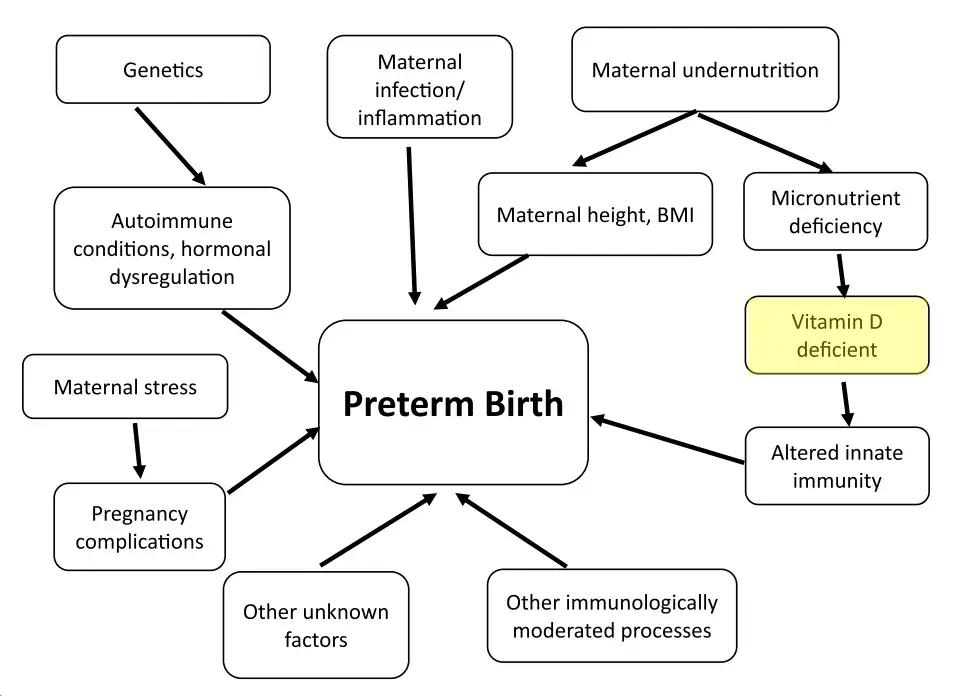Preterm births reduced by Vitamin D - many studies
Replaced by - Preterm birth and low Vitamin D - many studies
Preterm births are MORE likely if:
Obese - who have lower vitamin D levels
Dark-skin - who have lower D levels due to less D from the sun
Mother has a poor Vitamin D Receptor
Preterm births are LESS likely if more Vitamin D
Give Vitamin D to pregnant women
Preterm births are LESS likely if more Omega-3, etc.
Preterm Births decreased by Omega-3 (analysis of 184 countries) – April 2019
Preterm births strongly related to Vitamin D, Vitamin D Receptor, Iodine, Omega-3, etc
Pre-term birth - many of risk factors are associated with low vitamin D
{include}
Preeterm birth 1.53 X more likely if low vitamin D - May 2023
Vitamin D deficiency in pregnancy and the risk of preterm birth: a nested case–control study
BMC Pregnancy and Childbirth Vol 23, article number 322, (2023)
Tashnia Tahsin, Rasheda Khanam, Nabidul Haque Chowdhury, A. S. M. Tarik Hasan, Md. Biplob Hosen, Sayedur Rahman, Anjan Kumar Roy, Salahuddin Ahmed, Rubhana Raqib & Abdullah H. Baqui

Background
Each year, an estimated 15 million babies are born preterm. Micronutrient deficiencies, including vitamin D deficiency (VDD), are common in many low- and middle-income countries (LMICs), and these conditions are often associated with adverse pregnancy outcomes. Bangladesh experiences a high prevalence of VDD. The country also has a high preterm birth (PTB) rate. Using data from a population-based pregnancy cohort, we estimated the burden of VDD during pregnancy and its association with PTB.
Methods
Pregnant women (N = 3,000) were enrolled after ultrasound confirmation of gestational age at 8–19 weeks of gestation. Trained health workers prospectively collected phenotypic and epidemiological data at scheduled home visits. Trained phlebotomists collected maternal blood samples at enrollment and 24 -28 weeks of gestation. Aliquots of serum were stored at -80.0 C. We conducted a nested case–control study with all PTB (n = 262) and a random sample of term births (n = 668). The outcome, PTB, was defined as live births < 37 weeks of gestation, based on ultrasound. The main exposure was vitamin D concentrations of 24–28 weeks maternal blood samples. The analysis was adjusted for other PTB risk factors. Women were categorized as VDD (lowest quartile of 25(OH)D; < = 30.25 nmol/L) or not deficient (upper-three quartiles of 25(OH)D; > 30.25 nmol/L). We used logistic regression to determine the association of VDD with PTB, adjusting for potential confounders.
Results
The median and interquartile range of serum 25(OH)D was 38.0 nmol/L; 30.18 to 48.52 (nmol/L). After adjusting for co-variates, VDD was significantly associated with PTB [adjusted odds ratio (aOR) = 1.53, 95% confidence interval (CI) = 1.10 – 2.12].
The risk of PTB was also higher among women who were
shorter (aOR = 1.81, 95% CI: 1.27–2.57),
primiparous (aOR = 1.55, 95% CI = 1.12 – 2.12),
passive smokers (aOR = 1.60, 95% CI = 1.09 – 2.34), and those who
received iron supplementation during pregnancy (aOR = 1.66, 95% CI: 1.17, 2.37).
Conclusion
VDD is common in Bangladeshi pregnant women and is associated with an increased risk of PTB.
📄 Download the PDF from VitaminDWiki
Infant/Child and Vitamin D Receptor have articles
{category}
Vitamin D deficiency was widely prevalent among preterm neonates - July 2021
The potential effects of vitamin D deficiency on respiratory distress syndrome among preterm infants
Clin Nutr ESPEN.. 2021 Aug;44:243-246. doi: 10.1016/j.clnesp.2021.06.009
Abdulrahman Al-Matary 1, Yahia AlMalki 2, Samah Khalil 3, Emad AlHulaimi 4
Introduction: Vitamin D deficiency is one of the most commonly deficient vitamins worldwide. Preterm infants usually suffer from different complications. However, the relationship between vitamin D levels and RDS prevalence has been emerging in the last few years.
Aim: This study aimed to assess the severity of respiratory distress syndrome in preterm infants who are ≤34 weeks GA, with a birth weight of ≤2 kg, and its relation to their serum blood level of vitamin D.
Materials and methods: This is a multicenter study conducted at Neonatal Intensive Care Unit (NICU) at King Fahad Medical City (KFMC), Riyadh, Saudi Arabia, and Maternity and Children Hospital (MCH), Qassim, Saudi Arabia. We observed prospectively all preterm babies who were ≤34 weeks GA with 25-hydroxyvitamin D (25OHD) serum level ≤30 ng/ml at 24 h of life or less. Included infants were divided into 2 groups; infants with 25-hydroxyvitamin D level of ≤30 ng/ml were the deficient group and those with >30 ng/ml were considered in the normal group.
Results: 174 preterm infants were included in this study with an average gestational age of 30.2 ± 2.7 weeks.
The mean vitamin D level was 30.5 (SD 19.5).
Vitamin D deficiency was detected among 99 infants (56.9%). (<30ng?)
Of the deficient infants, (respiratory distress?)
42.4% moderate and (respiratory distress?)
31.3% were mild. (respiratory distress?)
Pneumothorax was 2.9% and mortality rates were recorded among 14 cases (8%).
Conclusion: Vitamin D deficiency was widely prevalent among preterm neonates . Pneumothorax, surfactant doses, oxygen, and mechanical ventilation requirements were statistically significant at vitamin D deficiency.
